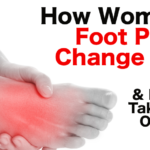Many women try to take good care of their bodies — whether your hair is prim and proper, you go to the salon every now and again to get a blowout or even go to the spa for facials and massages. However, a lot of women forget about their feet. When we neglect our feet, we neglect our health. Your feet tend to deteriorate and change over time. This is simply a natural process.
How your feet change at different ages:
Harvard Health lists an intensive description of how your feet change as people age.
The 30s – Muscles, tendons, and ligaments start to weaken.
The 40s – People start to experience foot pain from the weakening from the decade before. Many may start to feel sore at the end of the day. Common conditions people may experience in their forties are bunions or even hammertoes.
The 50s+ – the natural fatty foot padding starts to fade or by this point, it has already faded. After menopause, women may experience lower bone density due to the lower levels of estrogen. Many around this age group commonly experience calluses and corns.
How to take proper care of your feet:
Wash your feet and toes!
To maintain good hygiene, we must make it a point to wash our feet and toes (and in between toes, too). You are meant to wash your feet and toes every day and give them a nice scrub with soap and water. The Institute For Preventative Foot Health suggests washing and thoroughly drying your feet every day.
It is also important to make sure that your feet dry thoroughly, as wet feet may be prone to such foot issues such as athlete’s foot or stinky feet.
Shoes make a difference!
Most of the time, when women feel pain around the feet, this may be caused by shoes that are ill-fitting — too pointy, too high, too tight. Marian T. Hannan, a professor of medicine at Harvard Medical School and co-director of the Musculoskeletal Research Center at the Marcus Institute for Aging Research, Hebrew SeniorLife recommends switching to more comfortable shoes with support. She also notes that it is healthy to swap shoes, as wearing the same shoes every day can increase the chances for smelly feet.
Pedicures, foot baths, and spas, oh my!
If we take showers and baths, why not give that same treatment to our feet? Foot baths are incredibly important to feet hygiene. Harvard Health states a good foot bath can soften up calloused skin and help keep feet smooth. Once again, make sure to dry your feet thoroughly since fungi and bacteria thrive in wet environments.
If you prefer to go to the professionals, make sure to be picky! Pick a salon that sterilizes and cleans its equipment after every use to avoid bacteria and fungi accumulation.
Moisturize
Moisturizing your feet after taking a bath or shower is not only incredibly relaxing but can help to prevent drying and cracking, Hannan says. But don’t moisturize between the toes since this area does not necessarily need to be moisturized.
Change your socks
Changing socks every day helps you to avoid the accumulation of bacteria and can also help prevent stinky feet. FootcareMD.org recommends wearing thick, soft cotton socks to help draw moisture away from the feet.
Trim your toenails straight across
Cutting or trimming your toenails straight across may prevent ingrown nails. Ingrown nails occur when the nail digs in and grows into the adjacent skin, as defined by Harvard Health.
Sources:



